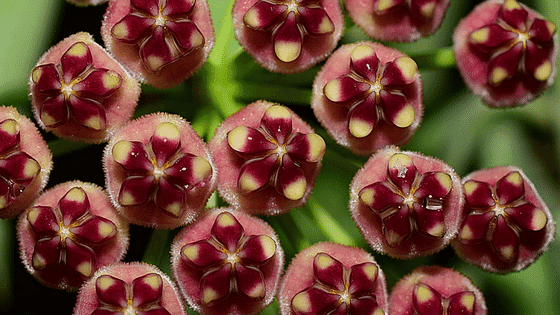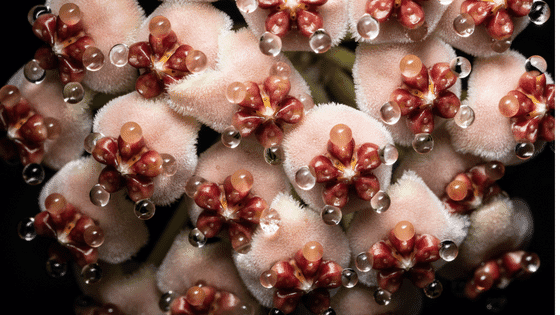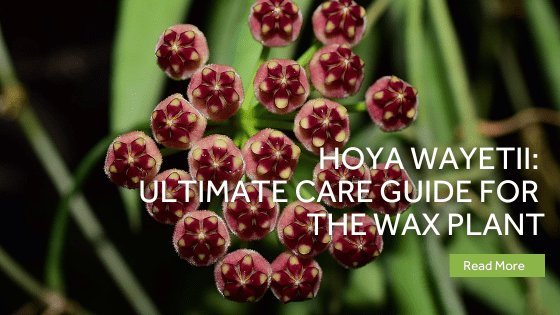The Hoya wayetii plant is for the patient gardener. It takes a long time to flower (years) and grows at a languid pace. However, it’s an easy to care for plant that makes it great for beginners or anyone looking for a vining plant to add to their home.
Table of Contents
Hoya Wayetii Overview
The Hoya Wayetti plant is from the Phillippines and is easily identifiable by its bright green leaves with dark brown and red edges. The Hoya wayetii is part of the Apocynaceae family and the Hoya genus. The wax-like flowers of this plant are what created its nicknames, including Wax Flower Plant, Porcelain Flower Plant, and Wax Vines.
Alocasia kentiana: Pointy, spear-shaped leaves that sprout small, butterscotch-scented flowers.
| Botanical Name | Hoya wayetii |
| Family | Apocynaceae |
| Genus | Hoya |
| Origin | Philippines |
| Sunlight | Bright, indirect sunlight |
| Watering | As needed, press soil to gauge saturation below surface-level soil |
| Soil | Well-draining soil mix |
| Temperature | 50 degrees Fahrenheit |
| Propagation | Stem cuttings |
| Re-Potting | Once overflowing from the original pot |
| Pests and Diseases | Mealy Bugs, Fungus Gnats, root rot |
| Toxicity | Can be irritating if ingested by those who are lactose intolerant |

Hoya Wayetii Features
Known as a flowering vine, the Hoya wayetii plant begins vining after it mounds for 1 – 4 inches. The vine itself grows to approximately 30 inches. The leaves are succulent green, but the edges or borders are brownish. The actual shade varies based on the amount of light the plant receives.
The wax plant leaves mature when they’re three to eight inches long, and the flowers grow in bunches of 10 – 20 in shades of red and purple. The flowers measure about a quarter inch.
The plant isn’t incredibly toxic, but it does belong to the milkweed family and has milk latex in its leaves. As a result, people with severe lactose allergies could suffer from allergic reactions if they ingest the plant or even come into contact with it.
You May Also Like: Hoya Pubicalyx: The Ultimate Care Guide
Hoya Wayetii Care Guide
Caring for the Hoya wayetii plant is simple. The plant is excellent for beginners or anyone who wants a plant that doesn’t require much care.
Ideal Growing Place
The nice thing about Hoya plants is you can grow them indoors or outdoors. They grow well in containers, pots, and hanging baskets. If you grow them outdoors, they make excellent ground cover in shady areas. They also grow with other plants and trees with similar watering and soil needs.
Hoya plants are tropical, so they don’t like cold temperatures. Therefore, they do best in areas with temperatures no lower than 50 degrees Fahrenheit.
Water
Hoyas don’t like to sit in water. However, it is easy to overwater them, so set yourself up on a watering schedule that suits the Hoya wayetii.
Before you water a Hoya, check that it needs it. Don’t judge the soil by the surface, as it can be deceiving. Even if the top of the soil is dry, underneath the surface may still have plenty of water. So instead, stick your finger or a stick in the soil. It doesn’t need water if you feel moisture within the first two inches.
When it does need watering, you should run water into the pot until you see it coming out of the drainage holes. Then, let all the water drain before putting the pot back in its pot. Don’t let the plant sit in water, and avoid using tap water. Instead, boil water (letting it cool completely before using it) or consider using deionized water.
Sunlight
Hoya wayetii plants require 70 – 90% of sunlight every day. This shouldn’t be direct light, though. If you have the plant indoors, keep it away from the window and direct light. Allow it to get sunlight without direct exposure. If you plant it outside, consider shady areas with some sun exposure, but not direct sun. If the leaves are left in direct sunlight, the leaves may burn.
Temperature
The Hoya Wayetti plant is very temperamental when it comes to temperatures. Since it’s a tropical plant, it wants warm temperatures only. Ideally, you would keep it at 60 – 85 degrees Fahrenheit.
If you plant it outside and leave it in a climate where the temperature gets below 50 degrees, make sure you can bring it indoors to keep it from freezing. They grow best in zone 11, where the weather is perfect for their growing season.
Soil
Hoya wayetii plants require a well-draining soil mix. This is so the plants don’t sit in water. Also, the water should be able to flow through the soil, so the roots don’t sit in water. Not many plants like wet roots, and if you grow this plant outside, use a bark mix and soil that includes perlite for the healthiest roots.
Humidity
Because of its tropical origins, the Hoya wayetii likes humid conditions. Most Hoya plants prefer humidity, but the wayetti needs the highest humidity levels. On average, the plant needs 60 – 80% humidity. Since this is higher than what most people have in their homes, you might need a humidifier in the room you have the plant if it’s indoors.
The plant can survive in lower humidity levels, but it may not be as healthy or robust as it could be if you had a humidifier in the room.
Fertilizer
Fertilizer for your plant is a matter of personal choice. If you’re okay with using fertilizer, look for one made for Hoya wayetii plants. You should only fertilize the plant during the growing season. During that time, fertilize it every other week using pellet or liquid fertilizer.
If you prefer a more natural approach, you can use organic matter such as ground coffee granules or green tea leaves on the top of your organic soil mix for fertilizer.
Pinching/Pruning
The Hoya wayetii is a vining plant, so it’s meant to have long trailing leaves. However, you can pinch and prune it as you need, depending on your desired length.
If you let it grow, pull off dead leaves, especially at the tips of the stems. This will give the plant a healthier appearance.
Potting and Re-potting
When you first get your Hoya wayetii plant, keep it in its original pot. Too many people want to report it immediately, but this can cause the plant to go into shock, which could cause issues with its growth rate.
Don’t be in a rush to report the Hoya wayetii plant, either. While some plants don’t like to be rootbound, the Hoya wayetii does. So you should repot it when the plant is busting at the seams, or it doesn’t seem to stay watered.
When you repot, choose a pot no more than 2 inches larger than your current pot. If you choose a pot that’s too large, you risk overwatering the plant since larger pots require more water.
Growth Zone
This Hoya Wayetti plant does best in Zone 11. In these areas, the temperatures don’t get below 40 degrees, allowing the plant to thrive.
Common Pests, Toxins, Diseases & Other Problems
Hoya plants don’t have many problems; however, pests can be an issue. They deal with mealybugs and fungus gnats, both of which can be harmful to the plant.
A mealybug infestation can cause the leaves to turn yellow. If the infestation is bad enough, it can spread to other plants too. The mealybugs suck the juice from your plant and lay eggs, making them hard to eliminate.
To prevent mealybugs, you can spray it with a pesticide or, for a more organic method, horticultural oil spray. If you have other plants in the house, isolate your Hoya, so the bugs don’t spread.
Fungus gnats often happen with overwatering. However, they aren’t a problem only for Hoyas; they can occur on any plant. Watch how much you water your plant and consider placing a layer of cinnamon over the top of the soil to prevent fungus gnats.
A common problem for Hoyas kept outdoors is fungal infections. This happens when the plant doesn’t get enough air. If you notice your plant has fungus, prune it carefully, removing all fungal areas.
Propagation
It’s best to propagate Hoya wayetii plants in the spring and summer when the weather is warm. To propagate, trim the stems 5 to 7 inches from the growing end of the plant. Be careful to cut below the node and have at least five cuttings for each plant.
Place the plant at least 3 inches deep in proper soil, keeping the nodes under the soil. Keep the plant in a warm area with plenty of indirect sunlight. When you water the soil, use a spray bottle, keeping the soil 70% dry in between waterings. It will take about three months to see growth.
Hoya Wayetii Mature Timeline
The downside of the Hoya wayetii plant is how slow it grows. It’s not unusual for the plant to take two to three years before it flowers. However, once it starts flowering, you will see flowers on the plant annually.

Hoya Wayetii FAQ
How Old Does Hoya Wayetii Have to Be Before They Bloom?
Most Hoya wayetii plants are two to three years old before they bloom flowers. Fortunately, your patience pays off with new flowers growing annually.
Is Hoya Wayetii a Fast Grower?
The Hoya wayetii is not a fast grower. Therefore, it’s not recommended for gardeners looking for a fast-growing plant. However, patience and proper care are rewarded with beautiful lavender flowers after a couple of years.
Are All Hoya Wayetii Variegated?
The variegated hoya wayetii has pink and red leaves as a young plant, but as the plant matures, the leaves become yellow and green with much darker borders. Beyond their color differences, variegated Hoyas are similar to their parent plant.
Does Hoya Wayetii Like to Climb?
The Hoya wayetii is known as a vining plant that works well on a trellis or in a hanging pot. Its leaves grow as long as you let them, developing beautiful flowers annually after a couple of years.
Do Hoyas Grow Aerial Roots?
Yes, Hoyas grow aerial roots that you can use to anchor the plant to your vine or trellis. Training the roots with a vine or trellis will get the plant to grow in the direction you desire. However, it also does well in hanging pots, allowing it to grow on its own.
Can I Use Tap Water for My Hoya Wayetii?
It’s not recommended to use tap water for your Hoya wayetii. If you do, collect the water a few days before you must use it and let it sit. If you need the water immediately, boil the tap water, waiting to water your plant until it cools.
What Do Hoya Wayetii Flowers Smell Like?
The scent of the Hoya wayetii flowers is very sweet, almost like butterscotch. The flowers only last a few days, so make sure to get your admiring in while they are around.
Is Hoya Wayetii a Succulent?
Yes, Hoya wayetii plants are succulent vines. Their wax-like leaves are reminiscent of traditional succulents, but you can enjoy them as a vine or hanging plant.
You May Also Like: Kalanchoe Tubiflora Mother of Millions Plant: Tips and Tricks
How Long Does a Hoya Wayetii Flower Last?
The Hoya wayetii flower lasts only a few days, usually five at most. However, they are gorgeous to look at and smell when they are there.
What Kind of Pot Is Suitable for Hoya Wayetii?
Keep your Hoya wayetii in its nursery pot as long as possible. Repotting it too soon can cause you to overwater it and hurt it. Wait until the plant busts out of the initial pot before repotting it.
What Is the Difference Between Hoya Wayetii vs Kentiana?
The Hoya wayetii and Hoya kentiana are very difficult to distinguish as they have similar appearances. They both have green and maroon leaves and similar flowers. The Hoya kentiana leaves, however, are longer than the Wayetti leaves, and the stem of the Kentiana near the flower is pink, and the Wayetti is green.
Are Hoya Plants Considered Invasive?
Typically, Hoya plants are not invading, but if you use them as ground cover and don’t keep them under control, they can get out of control.
Is Hoya Wayetii Rare?
The Hoya wayetii plant isn’t very common. You won’t find it in many nurseries, so you may have to shop around if you want to add it to your home.
Is Hoya Wayetii Toxic to Pets and Humans?
The Hoya plant isn’t toxic as far as being lethal, but it can cause issues for anyone allergic to lactose as its leaves contain milk lactose. Therefore, it’s best to keep it away from children and pets.
The Bottom Line
If you’re looking for a vining plant with rare leaves and beautiful flowers, the Hoya wayetii care is right for you. But, remember, you need patience waiting for it to grow and for flowers to appear. Once they do, though, your patience will be well worth it.
Last Updated on September 3, 2022 by Gustaf Johansson




